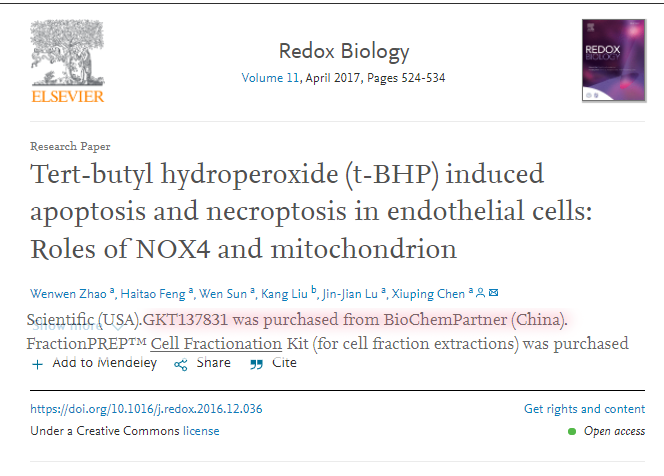Tert-butyl hydroperoxide (t-BHP) induced apoptosis and necroptosis in endothelial cells: Roles of NOX4 and mitochondrion

Abstract Oxidative stress causes endothelial death while underlying mechanisms remain elusive. Herein, the pro-death effect of tert-butyl hydroperoxide (t-BHP) was investigated with low concentration (50 μM) of t-BHP (t-BHPL) and high concentration (500 μM) of t-BHP (t-BHPH). Both t-BHPL and t-BHPH induced endothelial cell death was determined. T-BHPL induced caspase-dependent apoptosis and reactive oxygen species (ROS) generation, which was inhibited by N-acetyl-L-cysteine (NAC). Furthermore, NADPH oxidase inhibitor diphenyleneiodonium (DPI), NOX4 siRNA, and NOX4 inhibitor GKT137831 reduced t-BHPL-induced ROS generation while mitochondrial respiratory chain inhibitors rotenone (Rot), 2-thenoyltrifluoroacetone (TTFA), and antimycin A (AA) failed to do so. NOX4 overexpression resulted in increased ROS generation and Akt expression but decreased sensitivity to t-BHPL. In contrast, T-BHPH induced LDH release, PI uptake, and cell translucent cytoplasm. RIP1 inhibitor necrostatin-1 (Nec-1), MLKL inhibitor necrosulfonamide (NSA) and silencing RIP1, RIP3, and MLKL inhibited t-BHPH-induced cell death while pan-caspase inhibitor Z-VAD-FMK showed no effect. T-BHPH-induced ROS production was inhibited by TTFA, AA and Rot while DPI showed no effect. T-BHPH induced RIP1/RIP3 interaction, which was decreased by Rot, TTFA, and AA. Silence RIP1 and RIP3 but not MLKL inhibited t-BHPH-induced mitochondrial membrane potential (MMP) decrease and ROS production. Moreover, P38MAPK inhibitor SB203580 reversed both t-BHPL and t-BHPH-induced cell death while inhibitors for ERKs and JNKs showed no obvious effect. These data suggested that t-BHP induced both apoptosis and necroptosis in endothelial cells which was mediated by ROS and p38MAPK. ROS derived from NADPH oxidase and mitochondria contributed to t-BHPL and t-BHPH-induced apoptosis and necroptosis, respectively.




